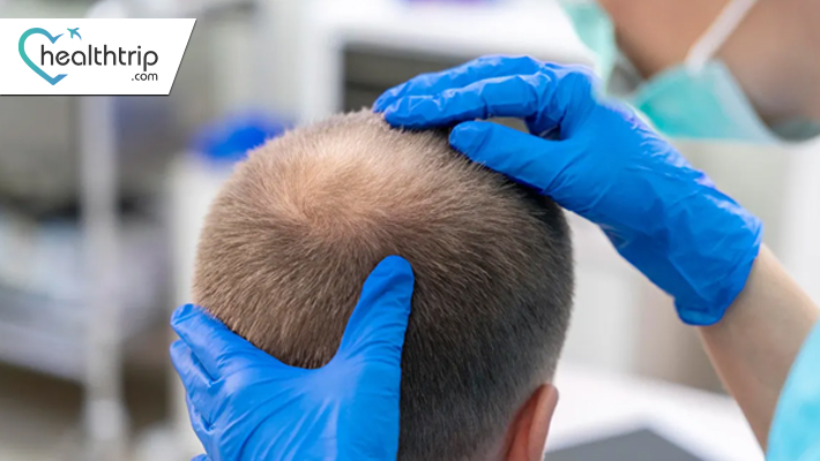Patients
served
Hospitals
Partner
Countries
Reached
Dedicated Assistance
in appointments, hotels, visa and forex
View all testimonials 
Consult with doctors across specialities
Healthtrip Blog
View All Articles 

How Uncommon Are Complications Following Tummy Tuck Surgery?
A tummy tuck, or abdominoplasty, is a popular cosmetic surgery procedure aimed at achieving a smoother and firmer abdominal profile. While many individuals experience successful outcomes, it's crucial to acknowledge the potential complications that can arise. In this blog, we will delve into the various complications associated with tummy tucks and explore their rarity in the context of this widely performed surgery.Understanding Tummy Tuck SurgeryBefore delving into complications, it's essential to understand the basics of a tummy tuck. This surgical procedure involves the removal of excess skin and fat from the abdominal region, often accompanied by the tightening of abdominal muscles. The goal is to create a more toned and aesthetically pleasing appearance.Common Complications: An Overview1. InfectionOne of the most common complications of post-tummy tuck is infection. The surgical site can become susceptible to bacterial contamination, leading to inflammation and discomfort. However, with proper post-operative care, including prescribed antibiotics and meticulous wound care, the risk of infection is significantly minimized.2. Hematoma and SeromaHematoma and seroma refer to the collection of blood or fluid under the skin, respectively. While these occurrences are relatively rare, they can occur, causing swelling, pain, and potential complications. Draining excess fluid or blood may be necessary to address these issues.3. Poor Wound HealingWound healing is a critical aspect of any surgical procedure. Poor wound healing may lead to visible scars, delayed recovery, or, in extreme cases, tissue necrosis. Factors such as smoking, diabetes, and poor blood circulation can contribute to compromised wound healing.4. Numbness and Sensation ChangesIt's not uncommon for patients to experience numbness or changes in sensation around the abdominal area following a tummy tuck. This is typically temporary, but in rare instances, it may persist. Nerve damage during surgery is a potential cause, emphasizing the importance of selecting a skilled and experienced surgeon.Assessing the Rarity of ComplicationsWhile complications are inherent risks in any surgical intervention, the incidence of issues following tummy tucks is relatively uncommon. Several factors contribute to this infrequency, and understanding them is crucial for prospective patients:1. Surgeon SelectionOpting for a board-certified and reputable plastic surgeon is a pivotal step in minimizing complications. A surgeon with extensive experience and positive patient reviews is more likely to execute the procedure with precision, reducing the likelihood of adverse events.2. Adherence to GuidelinesStrict adherence to pre and post-operative guidelines is paramount. Following the surgeon's recommendations regarding medications, activity restrictions, and wound care significantly contributes to a smoother recovery process.3. Overall Health MaintenanceA patient's overall health plays a crucial role in the success of the surgery. Maintaining a healthy lifestyle, including a balanced diet, regular exercise, and avoiding detrimental habits like smoking, can enhance the body's ability to heal and reduce the risk of complications.4. Pre-operative AssessmentsThorough assessments before surgery help identify potential risk factors. Open communication between the patient and the medical team ensures that any pre-existing conditions or concerns are addressed, allowing for proactive measures to be taken.5. Informed Decision-MakingPatients who are well-informed about the procedure, potential risks, and expected outcomes are better equipped to make informed decisions. This understanding fosters realistic expectations and contributes to a more positive post-operative experience.Minimizing Risks: Patient and Surgeon Responsibilities1. Pre-operative AssessmentThorough pre-operative assessments by the surgeon and anesthesiologist are essential to identify potential risk factors. Patients should disclose their medical history, including any pre-existing conditions, medications, and lifestyle factors that might impact the surgery.2. Surgeon ExpertiseSelecting a qualified and experienced plastic surgeon is paramount. Board certification, a proven track record, and positive patient testimonials can serve as indicators of a surgeon's expertise. A skilled surgeon will prioritize patient safety and take measures to minimize complications.3. Post-operative CareAdhering to post-operative care instructions is crucial for a smooth recovery. This includes taking prescribed medications, attending follow-up appointments, and avoiding activities that could strain the surgical site. Any concerns or unusual symptoms should be promptly communicated to the surgeon.ConclusionWhile complications after a tummy tuck are possible, they are, in fact, rare when the surgery is performed by a skilled and experienced surgeon and patients adhere to pre and post-operative guidelines. As with any medical procedure, understanding the potential risks and benefits is essential for making an informed decision. Ultimately, the majority of individuals undergoing tummy tucks achieve the desired results with minimal complications, contributing to increased confidence and satisfaction in their appearance.

Hair Transplant Cost in India
IntroductionHair loss can be a distressing experience, affecting one's self-esteem and confidence. Fortunately, hair transplantation has emerged as an effective solution to combat hair loss and regain a natural, youthful appearance. India has become a popular destination for hair transplants due to its world-class medical facilities, skilled surgeons, and cost-effective treatments. In this blog, we will delve into the factors that influence the cost of a hair transplant in India and why it has become a preferred choice for many.Understanding Hair TransplantationBefore diving into the cost aspects, let's briefly understand what a hair transplant is. Hair transplantation is a surgical procedure that involves removing hair follicles from one part of your body, usually the back or sides of your head, and transplanting them into bald or thinning areas. This process is done meticulously to ensure the natural growth of hair in the recipient area.Factors Influencing Hair Transplant Cost in IndiaType of Procedure: There are primarily two types of hair transplant procedures: Follicular Unit Transplantation (FUT) and Follicular Unit Extraction (FUE). FUT is generally more cost-effective than FUE because it involves removing a strip of scalp rather than individual follicles. The choice of procedure will significantly impact the overall cost.Number of Grafts: The cost of a hair transplant in India is often calculated based on the number of grafts required. The greater the extent of hair loss, the more grafts are needed, which directly affects the cost.Surgeon's Expertise: The experience and reputation of the surgeon play a crucial role in determining the cost. Highly skilled and renowned surgeons may charge more for their services.Location of the Clinic: The cost of living varies across India, and this can affect the pricing of medical procedures. Clinics in metropolitan cities like Mumbai, Delhi, and Bangalore may charge more than those in smaller towns or cities.Facility Quality: The quality of the medical facility, equipment used, and the overall experience provided can influence the cost. High-end clinics with state-of-the-art facilities may charge more.Additional Services: Some clinics offer additional services such as post-operative care, PRP therapy, and special packages. These services can add to the overall cost.Hair Transplant Cost Range in IndiaIn general, hair transplant surgery in India is much less expensive than in developed countries like the United States and the United Kingdom. The average cost of a hair transplant in India ranges from INR 30,000 to INR 1,20,000 (approximately USD 400 to USD 1,500). However, the cost can vary significantly depending on the factors mentioned above. It's important to note that the actual cost can vary from person to person based on individual needs and the factors mentioned earlier.ConclusionHair transplant cost in India is a fraction of what it may cost in many Western countries, making it an attractive option for those seeking a solution to hair loss. With skilled surgeons, state-of-the-art facilities, and a diverse cultural experience, India has emerged as a hub for affordable and high-quality hair transplant procedures. If you're considering hair restoration, India is certainly worth exploring as a destination for your treatment. However, it's essential to consult with a qualified medical professional to determine the best approach for your specific needs and budget.

Laser Hair Removal Treatment Cost in India
IntroductionIn recent years, laser hair removal has gained immense popularity as a convenient and effective method to get rid of unwanted body hair. India, with its burgeoning beauty and wellness industry, has embraced this technology wholeheartedly. But what exactly is the cost associated with laser hair removal treatments in India? In this blog, we will delve into the factors that influence the cost and provide you with insights on what to expect when considering this treatment.Understanding Laser Hair RemovalLaser hair removal is a medical procedure that uses a concentrated beam of light (laser) to remove unwanted hair. It works by targeting the hair follicles, damaging them to inhibit future hair growth. This method is preferred by many due to its long-lasting results and the relatively minimal discomfort it causes compared to traditional methods like waxing or shaving.Factors Influencing CostTreatment Area: The size of the area to be treated plays a significant role in determining the cost. Common treatment areas include the face, underarms, bikini line, legs, and back. Larger areas generally cost more than smaller ones.Number of Sessions: Achieving permanent hair reduction typically requires multiple sessions. The number of sessions needed depends on factors like hair color, skin type, and the targeted area. More sessions mean a higher overall cost.Clinic Location: The cost of laser hair removal can vary significantly depending on where the clinic is located. Clinics in metropolitan cities often charge more than those in smaller towns and rural areas due to higher operational costs.Clinic Reputation and Expertise: Established clinics with experienced staff and state-of-the-art equipment may charge more for their services. However, the higher cost is often justified by the quality of the treatment and the safety measures in place.Type of Laser Used: Different types of lasers are used for hair removal, and the choice of laser can affect the cost. Some lasers are more advanced and efficient, while others are older and less expensive.Pricing Structure: Some clinics offer package deals that include multiple sessions at a discounted rate. Others charge per session. Be sure to understand the pricing structure of the clinic you choose.Additional Costs: Consider any additional costs that may be involved, such as consultation fees, pre-treatment creams, or post-treatment skincare products.Cost Range in IndiaLaser hair removal is a popular cosmetic procedure that uses a concentrated beam of light to damage hair follicles and reduce hair growth. It is a safe and effective method of hair removal for most people, and it can be used on almost any area of the body, including the face, underarms, legs, bikini area, and back.In general, the average cost of laser hair removal treatment in India ranges from $20 to $40 per session. However, the cost can vary significantly depending on the factors listed above.Here is a table showing the approximate cost of laser hair removal treatment for different body areas in India:Treatment areaCost per session (USD)Upper lip$20-$25Underarms$25-$30Bikini line$30-$35Full legs$50-$60Full body$100-$150It is important to note that the above prices are just estimates. The actual cost of your treatment will vary depending on the factors listed above. It is always best to consult with a qualified dermatologist to get an accurate quote for your treatment.Read also:https://www.healthtrip.com/blog/face-laser-treatme...ConclusionLaser hair removal treatment is an effective and convenient solution for those looking to get rid of unwanted hair. While the cost of laser hair removal in India can vary, it's essential to prioritize quality and safety when choosing a clinic. Do your research, consult with multiple clinics, and consider the long-term benefits of this procedure. When done correctly, laser hair removal can be a worthwhile investment in your self-confidence and overall well-being.
We have been
in the News
View All 














